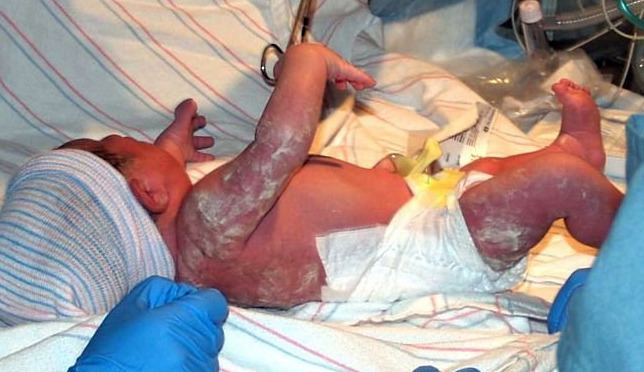 | ||
Vernix caseosa, also known as vernix, is the waxy or cheese-like white substance found coating the skin of newborn human babies.
Contents
Etymology
In Latin, vernix means varnish and caseosa means cheesy.
Composition
Vernix has a highly variable makeup but is primarily composed of sebum, cells that have sloughed off the fetus's skin and shed lanugo hair. 12% of the dry weight of vernix is composed of branched chain fatty acids, cholesterol and ceramide. Vernix of term infants has more squalene and a higher wax ester to sterol ester ratio than preterm infants.
Comparison of lipid components of vernix caseosa, stratum corneum and skin surface (sebaceous):
Amino acid composition of vernix caseosa:
Morphology
Cells of vernix are typically polygonal or ovoid in shape and lack nuclei. Nuclear ghosts are frequently observed. Vernix corneocytes lack desmosomal attachment and this distinguishes them from corneocytes found in mature stratum corneum. Thickness of a corneocyte is 1-2 µm. These cells are surrounded by a layer of amorphous lipids lacking typical lamellar architecture present in mature stratum corneum.
Physical properties
Vernix is not uniformly distributed, but rather present in form of cellular sponges. The critical surface tension of vernix is 39 dyne/cm. Despite its water content (82%), vernix is nonpolar. These features point towards the "waterproofing" function of vernix, thereby preventing heat loss soon after birth.
Biological properties
Vernix provides electrical isolation for the fetus, which is presumably an important aspect of developing fetal anatomy. Early scientific studies indicated increased evaporative heat loss in infants when vernix was removed soon after birth; but newer reports confirm that washing skin surface after birth reduces evaporative water losses compared to surface of newborns in which vernix is left in situ. Vernix is hydrophobic. Vernix is believed to assist in the development of the human intestinal microbiota.
Secretion
The sebum in vernix is produced in utero by the sebaceous glands around the 20th week of gestation. Vernix appears primarily in full term infants, while premature and postmature births generally lack any. Postdates desquamation (flakey skin in babies born >42 weeks) is thought to be due to loss of vernix.
Functions
Vernix is theorized to serve several purposes, including moisturizing the infant's skin, and facilitating passage through the birth canal. It serves to conserve heat and protect the delicate newborn skin from environmental stress. Vernix is also thought to have an antibacterial effect; though there is little evidence to support a chemical role of vernix in protecting the infant from infection, it may form a physical barrier to the passage of bacteria.
Non-human observations
Vernix has also been observed in aquatic mammals such as seals. Don Bowen, a marine biologist from Nova Scotia observes that seals have vernix, with harbour seals who swim immediately having more than other seals which do not swim for at least 10 days.
